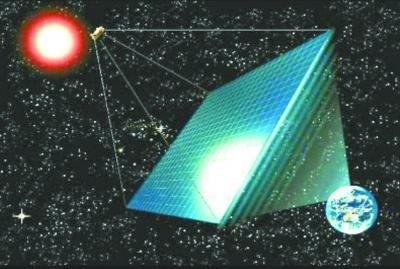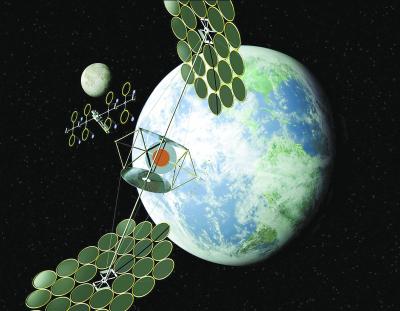
Tethered solar power station solution.

A plan of a tower space solar power station composed of a large number of solar cells.

Conceptual drawing of a space solar power station with integrated symmetrical concentrating system.
News background
Recently, China's first space solar power plant experimental base was launched in Chongqing. The basic experiments and applied research carried out after the base is completed will have great significance for the future construction of space solar power plants in China. In addition, the ground verification platform of the space solar power plant system project will also be completed in Xi'an, which is used for system verification of the function and efficiency of the space solar power plant.
So, what is a space solar power station? Why build solar power plants in space? How to build a space solar power station?
Unique advantage
At present, solar power generation on the ground has been very popular, mainly using solar panels to convert solar energy into electrical energy. In fact, the use of solar power in space is not new, because most of the artificial earth satellites, manned spacecraft and space probes are equipped with large and small solar battery wings, including the Chang'e-4 lunar probe that just landed on the back of the moon. The same is true of the device. However, the electricity generated by the solar cell wings of these spacecrafts is used by the spacecraft itself, and the scientists hope that the electricity generated by solar power stations built in space will be mainly used by thousands of households on the ground to provide huge clean energy for humans.
The sun is the inexhaustible core energy system of the earth and the entire solar system. However, the utilization rate on the ground is not high, because the use of solar energy on the ground will be greatly attenuated by the absorption and scattering of the atmosphere, the attenuation of cloud and rain, and the changes of seasons and day and night. The energy density also changes greatly and is very unstable.
However, solar energy is abundant in space. For example, in a geosynchronous orbit of 36,000 kilometers above the earth, since the sun rays will not be weakened by the atmosphere, and are not affected by the changes of seasons and day and night, the shadow period is very short, and the solar radiation can be stably received 99% of the time, its intensity It is more than 6 times that of the ground, and can realize the fixed point transmission of space to the ground. Therefore, building a solar power station in space can effectively use the solar energy on this orbit to provide human beings with high-quality, huge, and inexhaustible cleanliness. energy.
The development of space solar power stations can provide commercial, large-scale power supply to the ground and solve the long-term human demand for stable renewable energy. At the same time, the space solar power station has important application prospects for power supply in remote areas on the ground, emergency power supply, spacecraft power supply and environment regulation. At the same time, the development of space solar power stations will also lay the foundation for the development of a more long-term lunar solar power station.
Once it can overcome the space solar power generation technology, it is expected to gradually solve the energy crisis facing human society and obtain inexhaustible and sustainable clean energy. Therefore, space solar power plants are called "great changes in the energy field", and experts from China, the United States, and Japan are actively carrying out relevant research.
For now, space solar power plants are the most direct, effective, and achievable way to develop the Earth-Moon Space Economic Circle. It is much less difficult to develop lunar helium 3.
Facing huge challenges
Space solar power station refers to a power system that converts solar energy into electrical energy in space and then transmits it to the ground through wireless energy transmission. It mainly includes three major parts: solar power generation devices, energy conversion and transmission devices, and ground reception and conversion devices.
The solar power generation device converts solar energy into electrical energy; the energy conversion device converts electrical energy into microwave or laser (the laser can also be directly converted by solar energy), and uses the transmitting device to send the beam to the ground; the ground receiving system receives the spatial transmission beam, through The conversion device converts it into electrical energy and connects it to the grid.
The technical principles of space solar power plants are now not much of a problem. In recent years, solar power generation efficiency, microwave conversion efficiency and related aerospace technology have made great progress, laying a good foundation for the future development of space solar power stations. However, as a very large space system, the space solar power station needs to carry out systematic research work, and breakthrough progress needs to be made in many technical aspects. For example, to meet industrial application standards, the power generation requirements will be very high, at least in the megawatt level, and solar panels may also be calculated in square kilometers.
At present, experts in some countries have put forward a variety of space solar power station programs, each of which has its own merits, which has a high reference value for the design of practical space solar power stations in the future.
To date, the largest object launched by humans into space, the International Space Station, has more than 400 tons, while an industrial-grade solar power station has thousands of tons. Some experts in China suggest that the construction materials of space solar power plants be directly launched into space, establish a “space factory†in space, print out the required components through 3D technology, and then assemble them through space robots. This is one of the current research directions.
The space solar power station has a huge scale, with a mass of up to 10,000 tons, a scale of up to kilometers, a power generation level of megawatts, and a life expectancy of more than 30 years. Therefore, for new types of transportation, new materials, efficient energy conversion devices, and ultra-large spacecraft structures And control technology, on-rail assembly and maintenance technology, etc. have presented great technical challenges.
Long-term safety is also an issue that requires special attention. Although the beam density has been limited to meet the safety requirements from the perspective of system design, the long-term research work is still needed to affect the ecology, atmosphere, and organisms under long-term microwave radiation.
In short, the space solar power station needs to solve three key issues: one is how to transport the power generation equipment to the geosynchronous orbit and assemble the power generation through the large launch vehicle; the second is how to transmit the electrical energy to the ground; the third is how to ensure the safety and operation of the equipment environment safety. At present, these three issues are still in basic exploration.
Unlimited applications
The core application goal of the development of space solar power stations is to provide commercial, large-scale power supply to the ground, and to solve the long-term human demand for stable renewable energy. There are many fields of application. The space solar power station has important application prospects for power supply in remote areas, emergency power supply, spacecraft power supply and environment regulation. The development of space solar power stations will also lay the foundation for the development of a more long-term lunar solar power station.
Space solar power plants can provide clean and renewable energy to the ground without interruption, and provide huge and endless clean energy reserves for human beings. Assuming that a space solar power station is arranged at (space) geostationary orbit at every 0.5 ° interval (spacing about 360 kilometers), each space solar power station generates 5 megawatts of power, which can provide about 3.6 billion kilowatts of continuous power to the ground. electric power. The huge space power supply can also be used for desalination of the ground, hydrogen production, etc., which can be used for the use of other clean energy. Moreover, as a large-scale space power supply infrastructure, the space solar power station has a very wide coverage and can be flexibly used for power supply of ground moving targets and power supply in emergency situations, including remote areas, islands and disaster areas.
The space solar power station can also realize the power supply to the space orbit, medium orbit and high orbit spacecraft in the visible range, so that the spacecraft does not need huge solar battery wings, thereby greatly increasing the power level and control accuracy, which is for future high power The development of communication satellites, high-precision scientific satellites, etc. has important value. In the future, space solar power plants can also be used to directly produce space fuel and perform space processing and manufacturing, making future space industry development possible. Space solar power plants can also be used as candidates for deep space exploration energy systems.
The use of traditional fossil energy has caused the temperature of the earth to rise, and the frequent occurrence of severe weather such as typhoons and tornadoes has brought huge disasters to mankind. Transmitting the huge energy of the space solar power plant to the area where the tornado is located can change the temperature distribution of the typhoon, thereby destroying the formation process of the tornado. The use of space solar power plants can also slow down atmospheric haze and thus play a role in environmental regulation.
Non Woven Bag,Custom Nonwoven Bag,Spunbond Nonwoven Bag,Custom Nonwoven Vest Bag
Chongqing Yilun Sanzi new packaging Co., Ltd , https://www.yilunmask.com
![<?echo $_SERVER['SERVER_NAME'];?>](/template/twentyseventeen/skin/images/header.jpg)